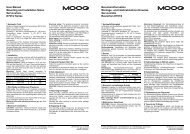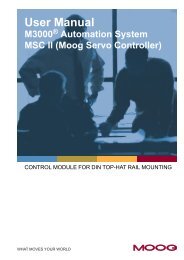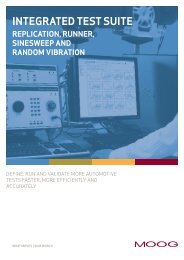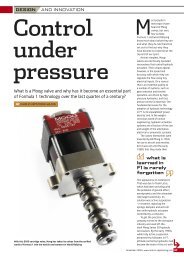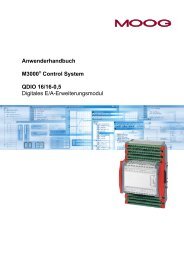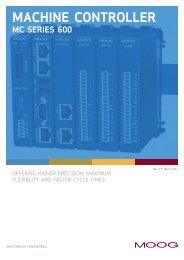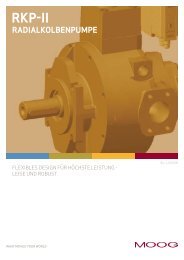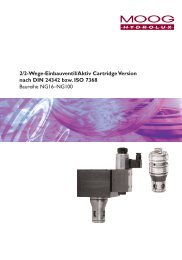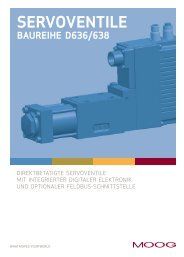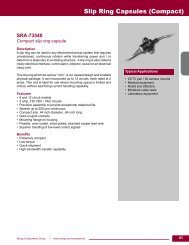brushless servomotor fastact g g400 series - Moog Inc
brushless servomotor fastact g g400 series - Moog Inc
brushless servomotor fastact g g400 series - Moog Inc
Create successful ePaper yourself
Turn your PDF publications into a flip-book with our unique Google optimized e-Paper software.
APPLICATION NOTES <strong>Moog</strong> | FASTACT G/G400 <strong>series</strong><br />
Mechanical Transmission Considerations:<br />
The following are the most common mechanical transmissions:<br />
• timing belt<br />
• cycloid and epicycloid reducer<br />
• rack and pinion<br />
• ball screw<br />
• Where n = transmission ratio, the load parameters are<br />
transferred to the motor axis according to the following<br />
relationships:<br />
-motor speed = load speed x n<br />
-motor torque = load torque / n<br />
-load inertia reflected to the motor axis = load inertia/n 2<br />
In order to identify the optimal mechanical transmission<br />
for an application, two main application areas can be<br />
identified:<br />
. Low Dynamic Applications:<br />
The main objective of the motion is the supply of power,<br />
the dynamic performances are not important, involved<br />
power is quite large, the motor cost is a significant<br />
percentage of the overall system cost.<br />
Version .0 | 0/2008<br />
2. High Dynamic Applications<br />
The main objective of the motion is mainly positioning<br />
with the most of energy used to accelerate, to brake<br />
and to position the load in a minimum time with maxi-<br />
mum accuracy.<br />
For non dynamic applications, simple speed reducers are<br />
acceptable.<br />
For dynamic applications, the required torques are mainly<br />
inertial. <strong>Moog</strong>‘s general recommendation is to orientate<br />
the choice towards inertial matching (transmission ratio<br />
which makes the load inertia translated to the motor axis<br />
equal to the motor inertia).<br />
When the load inertia transferred to the motor is more<br />
than a few times the motor inertia, a high control bandwidth<br />
is necessary to electronically compensate for the<br />
inertia mismatch and mechanical linkages must be stiff and<br />
with no backlash.<br />
Based onto these considerations, it is important to pay attention<br />
generating the torque either with a long and narrow<br />
motor or with a short and compact motor:<br />
• long motors are optimized for of minimum inertia so<br />
that they meet requirement of high accelerations with<br />
low inertia loads<br />
• short and compact motors are optimized for torsional<br />
stiffness so that they meet the requirements of high<br />
inertia loads<br />
In applications with large inertia and short positioning time<br />
a check must be made on the torsional resonance frequency<br />
to ensure it remains above 000 Hz assuming that a<br />
closed loop bandwidth in the order of 300Hz is achieved<br />
thanks to the high dynamic performances of G motors.<br />
The frequency of torsional resonance of a load with inertia<br />
Jl connected to an axis with torsional stiffness Sm is:<br />
f = ½*П* √Sm / Jl<br />
The torsional stiffness of a steel shaft whose diameter is D<br />
and whose length is L is:<br />
Sm = ( П*D 4 * 2.466*10 -3 ) / L<br />
Considerations on PT position Transducers<br />
A high performance <strong>brushless</strong> motor is required to have<br />
low inertia, high torque and high torsional stiffness. The<br />
next considerations are the mechanics of the feed system<br />
and the position transducer.<br />
Most common position tansducers are resolvers and<br />
encoders.<br />
Performances can dramatically be improved with encoders<br />
as they have:<br />
• 000 times better resolution than a resolver<br />
• 20 times better accuracy<br />
• 000 times better Signal/Noise ratio<br />
By using sinusoidal encoders, the rotational uniformity and<br />
the velocity dynamics are much higher. In other words, the<br />
sinusoidal encoder dramatically improves performance in<br />
terms of response time, servo error, overshoot and axis<br />
residual vibrations. With a sinusoidal encoder the static<br />
positioning accuracy is about 20 arcsec and, more importantly,<br />
the accuracy is not affected by the cabling quality.<br />
The dynamic error is limited by the Signal/Noise ratio<br />
A limitation to the adoption of encoders is the maximum<br />
allowed temperature which is on the order of 0 °C while<br />
a revolver is able to tolerate the 55°C of Class F. Encoders<br />
are typically more expensive than resolvers.<br />
Considerations on Electronics Drive Type<br />
In order to get the highest rotation uniformity at any<br />
speed, torque ripple must be minimized. To achieve this, careful<br />
choice of both sinusoidal motor and control system.<br />
The motor is matched to a sinusoidal PWM inverter, whose<br />
amplitude, frequency and phase are separately controlled.<br />
The PWM frequency used should be at least 0KHz.<br />
Currently, all <strong>Moog</strong> drives are fully digital with position,<br />
velocity, torque digital loops.<br />
Sampling time should be as short as possible to achieve<br />
wide system bandwidth.<br />
Reference signals (position or speed) are provided in analogue<br />
or digital form.<br />
Analogue reference is +/- 0V while digital reference can<br />
be provided using various protocols.<br />
29





